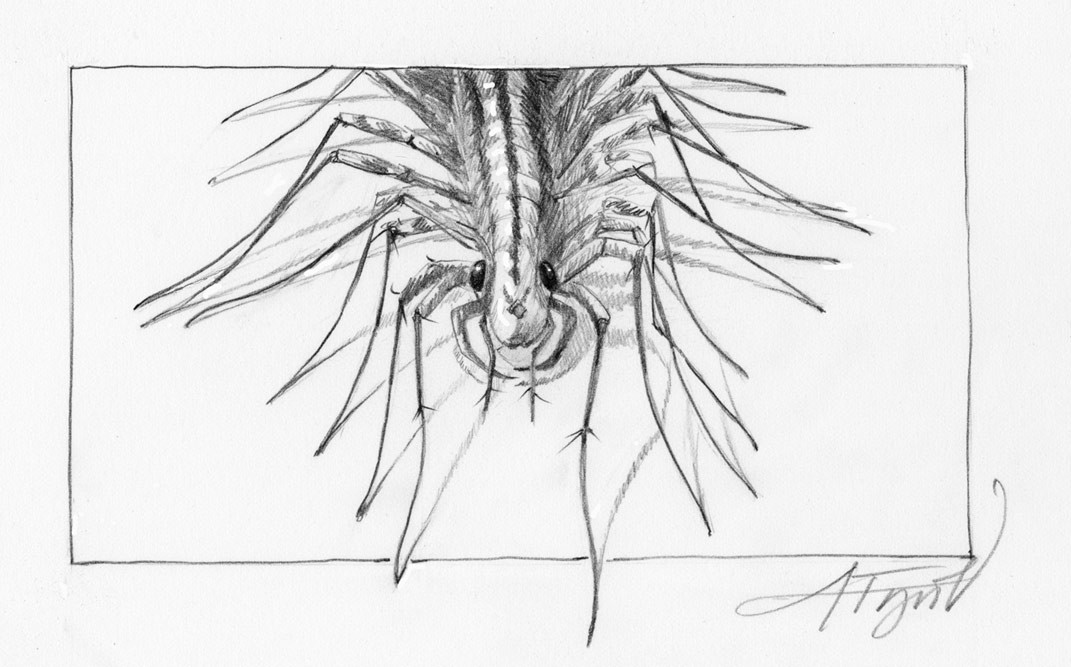
Inside our homes lives a collection of wildlife that is about as wild as life gets. Most of us are aware of the bigger stuff that wants to move in with us – pigeons, snakes, mice, squirrels, and even the occasional rat – and we work hard to get keep them out.
But it’s the little things that are most at home with us and harder to get rid of: the insects, the spiders, the mites, the centipedes – all of them arthropods.
Consider the house dust mite. Most of the information published about these little creatures claim they live in our homes by the thousands or even the millions. We provide them with their favorite food – flakes of our dead skin – and our dwellings are their natural habitat.
If we could see one, we would see that it is an ugly little animal. It has eight stout, hairy legs, a scaly body, a hunched back, and a head dominated by mouth parts that look like pliers. At 300 microns, it is less than half the size of the period at the end of this sentence. If house mites were suddenly to become 100 times larger, about the size of an inch, we would probably flee from our homes in terror.
Curious naturalist that I am, I began looking around for them. Using my little 10-power magnifying lens like a monocle, I searched the fibers in my pillow, in my sheets, in my slippers – all the places I read where they liked to hang out.
After a few hours of up-close searching, I had not found a single one. Perhaps my fifty-five-year-old eyes were not up to the task. Or perhaps I did not have any dust mites. Given that I couldn’t see them, I decided I could live with them.
I believe in living in harmony with wildlife, generally speaking, even the wildlife that decides su casa es mi casa. I ignore the spiders that hang out in the corners of my ceilings and the occasional ant that walks across my kitchen floor. I don’t mind a mouse or two living in the cellar. Certainly I would never consider using chemical poisons to kill insects in my home.
Though there was one morning, while drinking a cup of coffee, when I noticed a little copper-colored bug slowly crawling up my arm. It was the first time I had ever come face to face with a bed bug. Even though I knew that bed bugs do not carry human diseases, I found myself in a panic.
I called the health department.
“Are you sure it’s a bed bug?” asked the man to whom I was transferred.
“Yes, I’m sure.”
He had no advice to offer me about how to get rid of them. In his 17 years at the health department, he had never gotten a single complaint about bed bugs. This was 10 years ago, before the recent resurgence of the bloodsuckers. They are popular once again.
That night I could not sleep. I kept jumping up, flipping on the lights, and turning back the sheets to check for the little vampires. I was sure I could feel them crawling on me, thirsty for my blood.
A few days later, I went to the pet store and bought some spray cans full of a pesticide that promised to get rid of fleas. I hoped it would also kill bed bugs. I sprayed my mattress and my pillows and the bedroom floors and behind the woodwork, all the places I read bed bugs were likely to lurk.
I never saw another bed bug, and until this day, I’ve remain in the closet about the whole episode. Still, I am ashamed, both because I got bed bugs and because I vigorously applied chemical pesticides to get rid of them.
This summer a new animal moved in with me – a house centipede. One inch long, with three dark stripes running down its back and 15 pairs of long, striped legs, the house centipedes were active at night. They darted quickly this way and that across my rug, attracting my attention and my cats’.
Curious about this new roommate, I read up on it. Indigenous to the Mediterranean region, the house centipede was introduced to America through Mexico and Guatemala in the mid-1800s. Now it is found as far north as Canada. They kill other arthropods by stinging them using modified legs to inject them with venom. Some sources say they are harmless to humans. Other sources contradict this and say they can deliver a painful sting to us, although they only sting in defense.
Should I worry about them? I kept reading and found out that house centipedes eat cockroaches and spiders and ants and silverfish – and bed bugs.
I think I will leave them alone.

